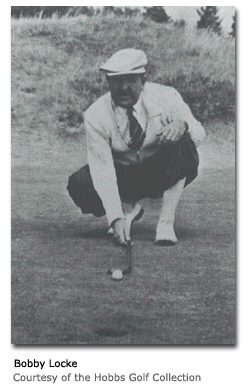|
 and Walter Hagen (from whom he learned his method). He won by a shot
from his partner, the 22-year-old Peter Thomson, who was playing in
only his second Open. It was Locke’s third win in four years. and Walter Hagen (from whom he learned his method). He won by a shot
from his partner, the 22-year-old Peter Thomson, who was playing in
only his second Open. It was Locke’s third win in four years.
Thomson and Locke were embarking on a period of great rivalry and
between them won seven Opens out of ten from 1949 to 1958.
45-year-old Henry Cotton, appearing for the first time since 1948,
finished with two birdie 3s for a 71 and fourth place – another of
his masterful performances in the wind. Had it been as rough
throughout I believe he would have won and made it four titles. His
health was in gradual decline after the war and every year he said
it would be his last appearance, but there were a few more to come.
He finished sixth in Peter Thomson’s hat-trick Open at Hoylake in
1956, when he was nearing fifty; in 1957 he was in a tie for 9th
with Max Faulkner in Locke’s last Open win at St Andrews, scoring a
69 in the third round and when Thomson won his fourth open at Lytham
in 1958 Henry had a 68 and a 69, finishing in a share of 8th place
with Harry Weetman and Eric Lester. Eric, a young player from the
Bristol and Clifton club, was one of those I had written of as ‘one
to watch’ if he could gain consistency, but he never quite fulfilled
his potential.
I wonder how many Opens Henry Cotton might have won if he had
remained fit. Later in 1952 he left Royal Mid Surrey for the Temple
Golf Club in Berkshire and Jimmy Adams, who had gone to Royal Sydney
that February, came back to take his place.
I played with Bobby Locke in the North British tournament and found
it an enjoyable experience. His pace never varied, but he had a
wonderful temperament and was a pleasant companion on and off the
course. He played with a pronounced hook and lined up at least 45
degrees to the right of the target on all his full shots, but he
found the fairways and greens with remarkable consistency. Bobby’s
framed card displayed in the clubhouse at Royal Ashdown Forest
commemorates one very consistent round he played in their 1936 Open
Amateur tournament – it is marked with 18 fours!
Bobby had put on a lot of weight since I had first seen him as a
19-year-old at Hoylake in that same year and he was now a portly
figure, with a jowly visage, but he was still remarkably supple. He
took the advice of Sam Snead, who christened him ‘droopy jowls’, and
competed in America in 1947 and 1948, where he became known as ‘Old
Muffin Face’. He had two very successful seasons in the USA but,
disillusioned by resentment both of his success and the size of his
appearance money, he preferred to play in Europe thereafter. He was
always immaculately dressed in shirt, tie, cashmere sweater, white
cap and, before forsaking them after the incident in his last Open
victory at St Andrews in 1957, he always wore very baggy navy-blue
plus fours. He had a reputation for being ‘careful’ with his money
and a joke going around at the time said that his plus fours had
pockets going right to the bottom.
1953 was an eventful year. People gathered around 12" black and
white TVs to watch the Queen’s coronation; to marvel at the skill of
38-year-old Stanley Matthews as Blackpool won the Cup in the most
memorable final of all; to cheer Len Hutton’s England team as they
regained the Ashes after twenty years and to see pictures of Hilary
and Tensing standing on the top of the World. Henry Cotton captained
the Ryder Cup team at Wentworth -which we could, and should, have
won that year, but it all went ‘pear shaped’ and we lost again - by
one point. The first live televised Open did not come until 1957 so
they had to wait for the newsreels to see Ben Hogan conquer golf’s
Everest – Carnoustie, at his first and only attempt on the
championship. He had already won the Masters and US Open and his
record of three majors that year was not equalled until Tiger Woods
came along. He might have made it four if the US PGA Championship
had not clashed with the Open. Hogan followed Gene Sarazen to become
the second winner of the modern grand slam and confirm his
reputation as the world’s greatest golfer at that time. He achieved
this after his near fatal car crash in 1949 had left him with
severely damaged legs, which pained him for the rest of his life.
The following year he won the US Open and made it a total of six
majors in three years, bringing his tally to nine. The strength of
character he showed in overcoming his disability put me in mind of
my brother Charles.
NEXT |

 and Walter Hagen (from whom he learned his method). He won by a shot
from his partner, the 22-year-old Peter Thomson, who was playing in
only his second Open. It was Locke’s third win in four years.
and Walter Hagen (from whom he learned his method). He won by a shot
from his partner, the 22-year-old Peter Thomson, who was playing in
only his second Open. It was Locke’s third win in four years.